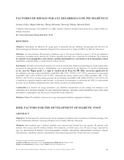| dc.rights.license | http://creativecommons.org/licenses/by-nc-sa/3.0/ve/ | es_VE |
| dc.contributor.author | Calles, Oriana | |
| dc.contributor.author | Sánchez, Miguel | |
| dc.contributor.author | Miranda, Tibisay | |
| dc.contributor.author | Villalta, Darwing | |
| dc.contributor.author | Paoli, Mariela | |
| dc.date.accessioned | 2020-11-12T18:09:14Z | |
| dc.date.available | 2020-11-12T18:09:14Z | |
| dc.date.issued | 2020 | |
| dc.identifier.issn | 1690-3110 | |
| dc.identifier.uri | http://www.saber.ula.ve/handle/123456789/47079 | |
| dc.description.abstract | Objetivo: Determinar los factores de riesgo para el desarrollo de pie diabético en pacientes del Servicio de
Endocrinología del Instituto Autónomo Hospital Universitario de Los Andes (IAHULA), Mérida, Venezuela.
Métodos: Se seleccionaron 100 pacientes diabéticos tipo 2, 50 con pie diabético (casos) y 50 sin pie diabético
(controles), de ambos sexos, mayores de 18 años, pareados por edad, sexo y duración de la diabetes. Se evaluaron
las variables socio-demográfi cas, antecedentes, medidas antropométricas, características de la enfermedad, control
metabólico, comorbilidades y características clínicas del pie.
Resultados: No hubo asociación del estado civil, nivel de instrucción, hábitos psicobiológicos, estado nutricional,
presencia de hipertensión arterial o dislipidemia, con la presentación de pie diabético. La lesión predominante
en los casos fue Wagner grado 2, y según la clasifi cación de Texas fue IIB. Hubo asociación signifi cativa de
pie diabético con mal control metabólico (p=0,003; OR: 3,451; IC95%:1,517-7,852), presencia de neuropatía
(p=0,0001; OR: 5,670; IC95%:2,144-14,997), alteración del índice tobillo brazo (ITB) (p=0,004; OR: 3,545;
IC05%:1,487-8,454) y el antecedente personal de pie diabético (p=0,0001; OR: 8,609; IC95%:3,110-23,832). En
el análisis de regresión logística multivariante, la presencia de neuropatía, la alteración del ITB y el antecedente
personal de pie diabético permanecieron como factores predictivos independientes.
Conclusión: Los factores de riesgo asociados a pie diabético encontrados en este trabajo son similares a los
reportados en la literatura mundial. Es muy importante mantener adecuado control metabólico para evitar daño
neuropático y angiopático que favorecen el desarrollo de pie diabético. | es_VE |
| dc.language.iso | es | es_VE |
| dc.publisher | SaberULA | es_VE |
| dc.rights | info:eu-repo/semantics/openAccess | es_VE |
| dc.subject | Pie diabético | es_VE |
| dc.subject | Factores de riesgo | es_VE |
| dc.subject | Neuropatía diabética | es_VE |
| dc.subject | Angiopatía diabética | es_VE |
| dc.title | Factores de riesgo para el desarrollo de Pie Diabético | es_VE |
| dc.title.alternative | Risk factors for the development of Diebetic Foot | es_VE |
| dc.type | info:eu-repo/semantics/article | es_VE |
| dcterms.dateAccepted | Septiembre 2019 | |
| dcterms.dateSubmitted | Febrero 2020 | |
| dc.description.abstract1 | Objective: To determine the risk factors for the development of diabetic foot in patients of the Endocrinology Unit
of the Autonomous Institute University Hospital of Los Andes, Mérida, Venezuela.
Methods: One hundred type 2 diabetic patients were selected and divided into two groups: 50 patients with
diabetic foot (cases) and 50 without diabetic foot (controls), of both sexes, over 18 years of age, matched by
age, sex and duration of diabetes. Socio-demographic variables, antecedents, anthropometric measures, disease
characteristics, metabolic control, comorbidities and clinical characteristics of the foot were evaluated.
Results: There was no association of marital status, education level, psychobiological habits, nutritional status, and
presence of arterial hypertension or dyslipidemia, with the presentation of diabetic foot. The predominant lesion
in the cases was Wagner grade 2, and according to the Texas classifi cation, it was IIB. There was a signifi cant
association of diabetic foot with poor metabolic control (p=0.003; OR:3.451; 95%CI:1.517-7.852), presence of
neuropathy (p=0.0001; OR:5.670; 95%CI:2.144-14.997), alteration of the ankle arm index (p=0.004; OR:3.545;
IC05%:1.487-8.454) and the personal history of diabetic foot (p=0.0001; OR:8.609; 95%CI:3.110-23.832). In the
multivariate logistic regression analysis, the presence of neuropathy, the alteration of the ankle arm index and the
personal history of diabetic foot remained as independent predictive factors.
Conclusion: The risk factors associated with diabetic foot found in this study are similar to those reported in the
world literature. It is very important to maintain adequate metabolic control to avoid neuropathic and angiopathic
damage that favor the development of diabetic foot. | es_VE |
| dc.description.colacion | 65-79 | es_VE |
| dc.description.email | rvdeme@gmail.com | es_VE |
| dc.description.email | orianaca15@gmail.com | es_VE |
| dc.description.email | dr_sanchezmm@hotmail.com | es_VE |
| dc.description.email | tibisaymiranda4@gmail.co | es_VE |
| dc.description.email | darwingvillalta@hotmail.com | es_VE |
| dc.description.email | paolimariela@hotmail.com | es_VE |
| dc.description.frecuencia | Cuatrimestral | |
| dc.description.paginaweb | http://www.saber.ula.ve/handle/123456789/26654 | |
| dc.identifier.depositolegal | ppi. 200902ME4351 | |
| dc.publisher.pais | Venezuela | es_VE |
| dc.subject.institucion | Universidad de Los Andes | es_VE |
| dc.subject.keywords | Diabetic foot | es_VE |
| dc.subject.keywords | Risk factors | es_VE |
| dc.subject.keywords | Diabetic neuropathy | es_VE |
| dc.subject.keywords | Diabetic angiopathy | es_VE |
| dc.subject.seccion | Revista Venezolana de Endocrinología y Metabolismo: Originales | es_VE |
| dc.subject.tipo | Revistas | es_VE |
| dc.type.media | Texto | es_VE |


